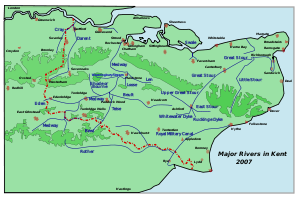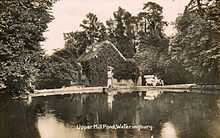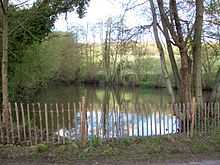Wateringbury Stream
| Wateringbury Stream known as Bratton Stream in Mereworth | |
|---|---|
| Origin | West Peckham |
| Mouth | River Medway |
| Length | 4 miles (6.4 km) |

The Wateringbury stream rises at Swanton, West Peckham parish, flows south east towards Mereworth and then flows in a generally easterly direction to join the River Medway at Wateringbury. It is some four miles (6 km) long and powered a number of watermills.
Watermills
Mereworth Mill.
TQ 673 535 51°15′22″N 0°23′55″E / 51.256008°N 0.398537°E
The Domesday Book records two mills, value 10/-, at Marovrde (Mereworth). The site of the last mill now lies in the private grounds of Mereworth Castle. In 1460, it was held by Thomas Hunte. In 1521 it was a fulling mill, belonging to Sir Thomas Nevyle. In 1772 James Pound was the occupant, followed by his widow in March 1780 and John Pound in September 1780. He was at the mill until October 1791. Thomas Edmead was at the mill from 1792-1827. The mill was purchased by Viscount Falmouth c.1856. The mill was demolished by 1907 and the site is today marked by a waterfall at the eastern end of the lakes in the grounds of Mereworth Castle. The head would have been some 8 feet (2.44 m) or 10 feet (3.05 m), suggesting a high breast shot or overshot waterwheel.[1][2][3]
Mill at Wateringbury
The Domesday Book records three mills at Otringeberge (Wateringbury). Two mills were held by Ralf, son of Turald and valued at 3/-, a third was held by Hugh de Braibourne and worth 16d.
This mill was marked on C & G Greenwood's map of Kent, 1822. It was not mentioned in a survey of the parish carried out in 1828.[4]
Brattle (Upper) Mill, Wateringbury
TQ 686 534 51°15′17″N 0°25′02″E / 51.254726°N 0.417104°E

Warden Mill, Wateringbury
TQ 690 532 51°15′10″N 0°25′22″E / 51.252811°N 0.422737°E
Warden Mill was a corn mill that took its name from the farm to which it belonged, Warden Farm. The first reference to this mill was in November 1822, when John Savage of Cobham leased the mill from John Selby of Marden and John Fellow of Eynsford. In October 1829 James Fremlin took over the lease. Selby and Fellow(s) held the freehold of the mill until October 1838. In 1839 the area of the mill pond was given as ¾ acre. Charles Whittaker was the owner of the mill in 1842 and by April 1845 Whittaker and Fremlin were joint owners, but by November 1847 the mill had passed back to John Selby. James Fremlin purchased a moiety of the property in October 1871. He purchased the other share in the property in December 1876. Richard Clemetson took over the mill between 1878 and 1887, followed by William James Hawes sometime between 1890 and 1895. The mill last worked in 1913 and was demolished c.1914. The head of water was some 8 feet (2.44 m). It is thought that this mill had a breast shot waterwheel.[7][8]
Possible water power site

A site close to the source of the Wateringbury Stream shows some characteristic signs of previous use of waterpower.
Swanton, Mereworth
TQ 646 539 51°15′37″N 0°21′36″E / 51.260388°N 0.360059°E
A large pond high in the Swanton valley may indicate the site of an old furnace mill. The head available being sufficient to power a large overshot waterwheel.
Holy Well
TQ 676 532 51°15′14″N 0°22′27″E / 51.253809°N 0.374055°E
The Wateringbury Stream flows past a group of cottages in Pizien Well Road, Wateringbury. The name Pizien may be a corruption of Poison. Local superstition was that a bride would drink the water from the well to ensure fertility. [9]
Ford

A track crosses the Wateringbury Stream by means of a ford at TQ 680 531. 51°15′08″N 0°24′30″E / 51.252208°N 0.408372°E [10]
References
- ↑ Fuller, Michael (1980). The Watermills of the East Malling and Wateringbury Streams. Maidstone: Christine Swift. pp. Part 2, Chapter 1.
- ↑ Fuller & Spain (1986). Watermills (Kent and the Borders of Sussex). Maidstone: Kent Archaeological Society. pp. p103. ISBN 0-906746-08-6.
- ↑ Thirsk, Joan (editor) (2007). Hadlow, Life, Land & People in a Wealden Parish 1460 ~ 1600. Kent Archaeological Society. p. p190. ISBN 978-0-906746-70-7.
- ↑ Fuller, Michael (1980). The Watermills of the East Malling and Wateringbury Streams. Maidstone: Christine Swift. pp. Part 2, Chapter 2.
- ↑ Sussex Mills Group
- ↑ Fuller, Michael (1980). The Watermills of the East Malling and Wateringbury Streams. Maidstone: Christine Swift. pp. Part 2, Chapter 3.
- ↑ Fuller, Michael (1980). The Watermills of the East Malling and Wateringbury Streams. Maidstone: Christine Swift. pp. Part 2, Chapter 4.
- ↑ Fuller & Spain (1986). Watermills (Kent and the Borders of Sussex). Maidstone: Kent Archaeological Society. pp. p135. ISBN 0-906746-08-6.
- ↑ Living Spring
- ↑ Wetroads
See also
Medway watermills (lower tributaries) article
| ||||||||